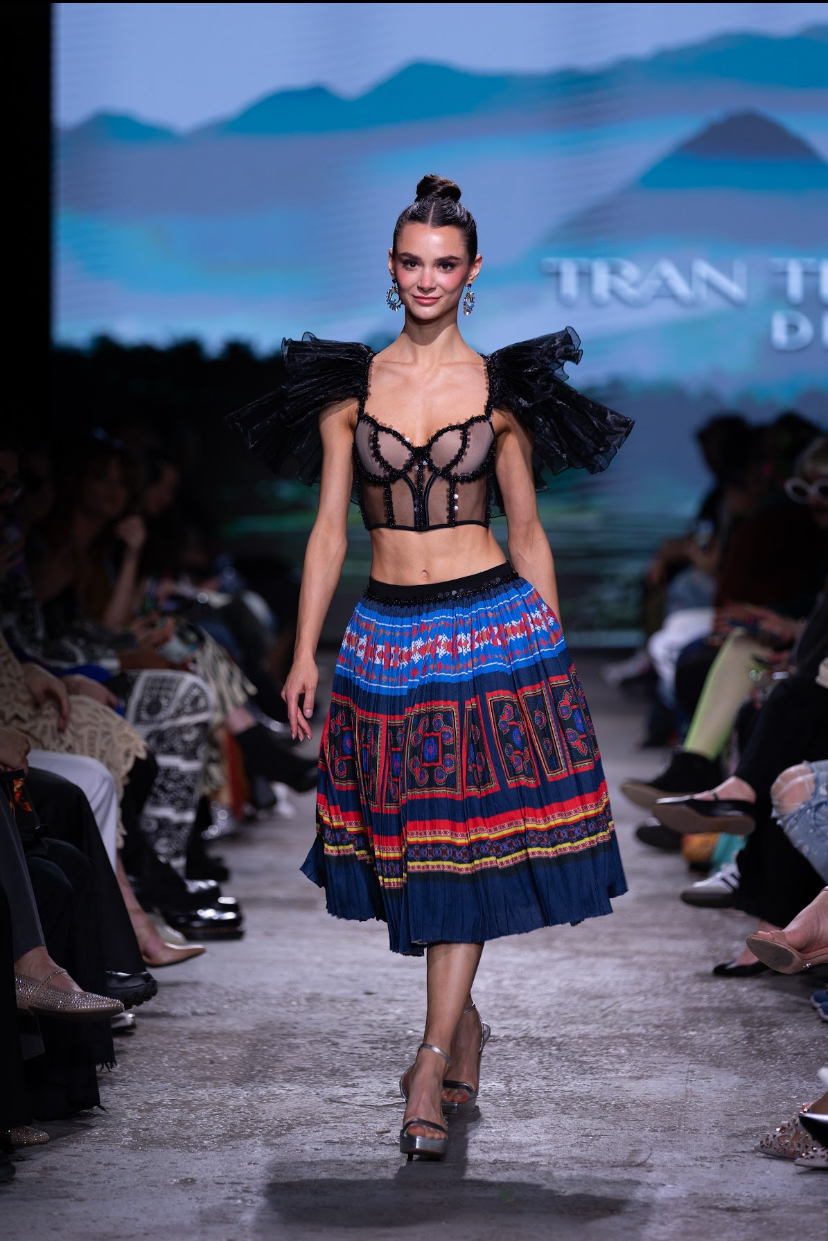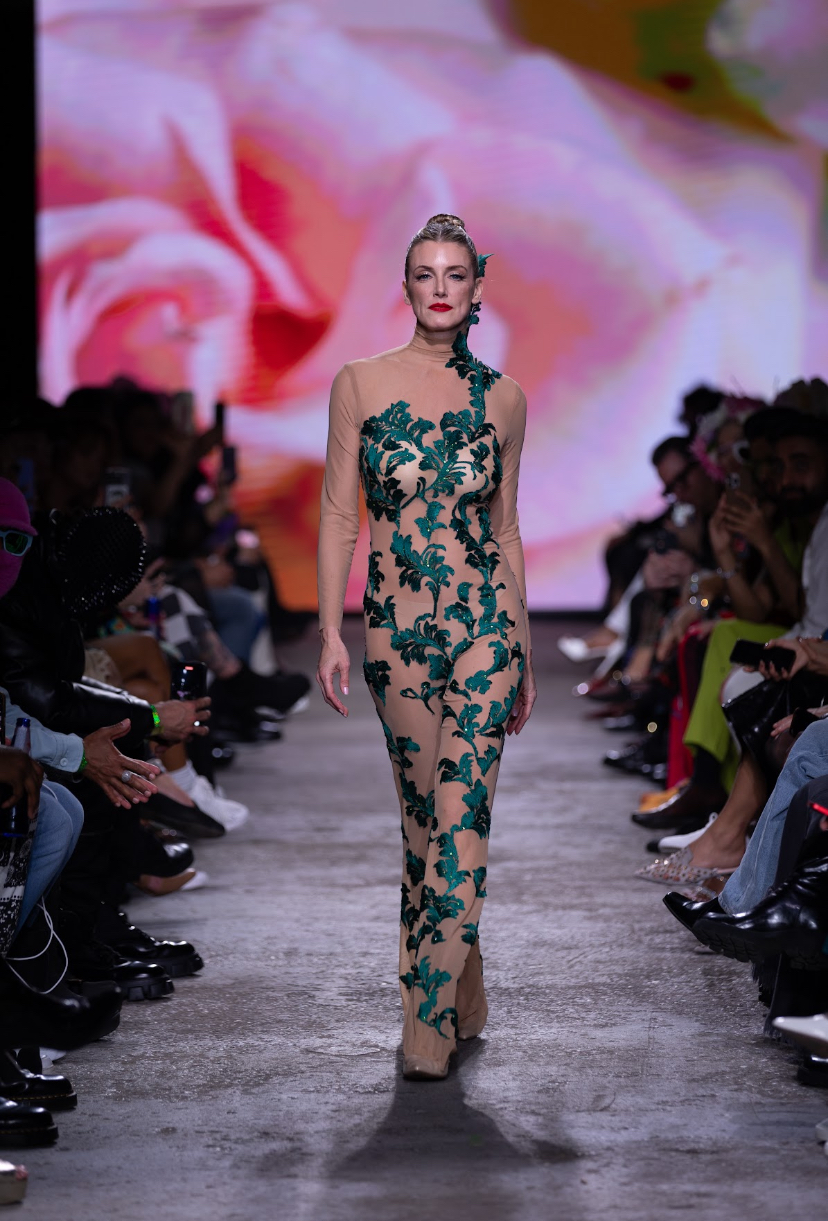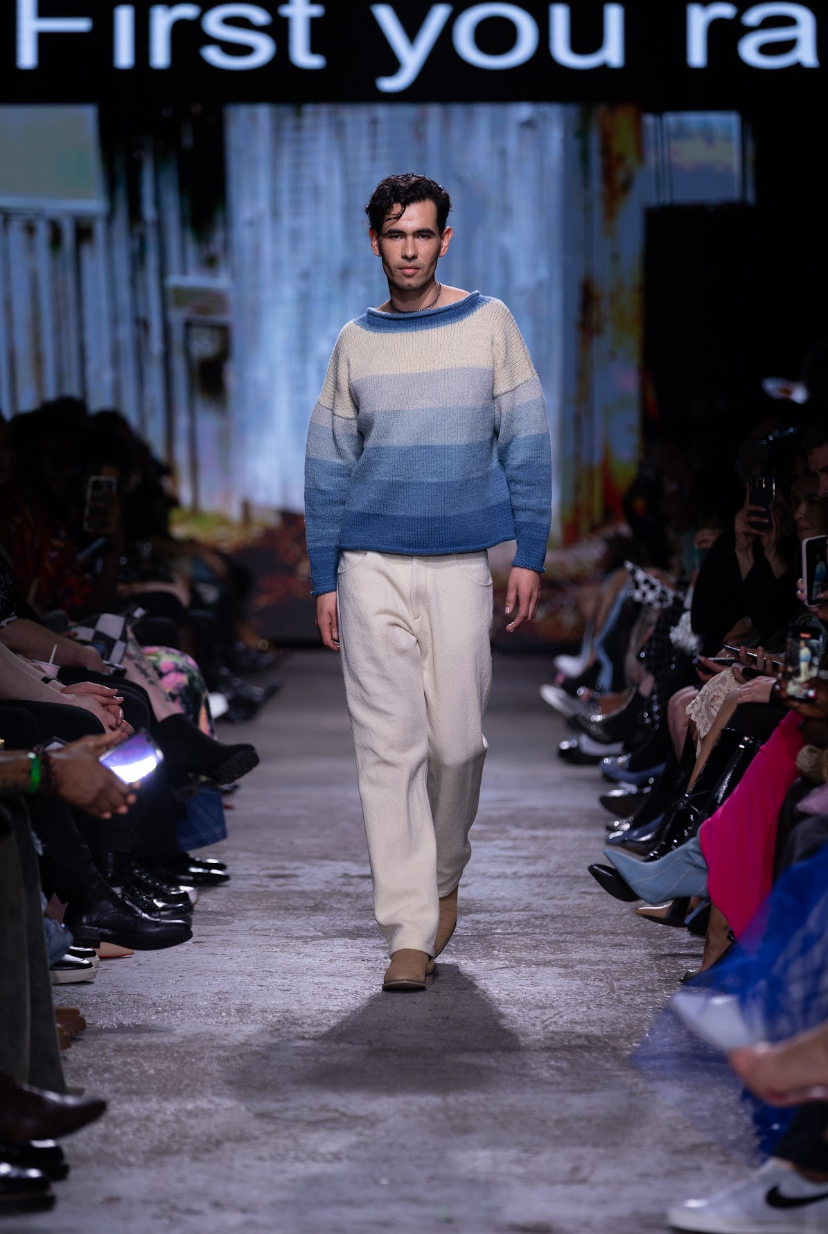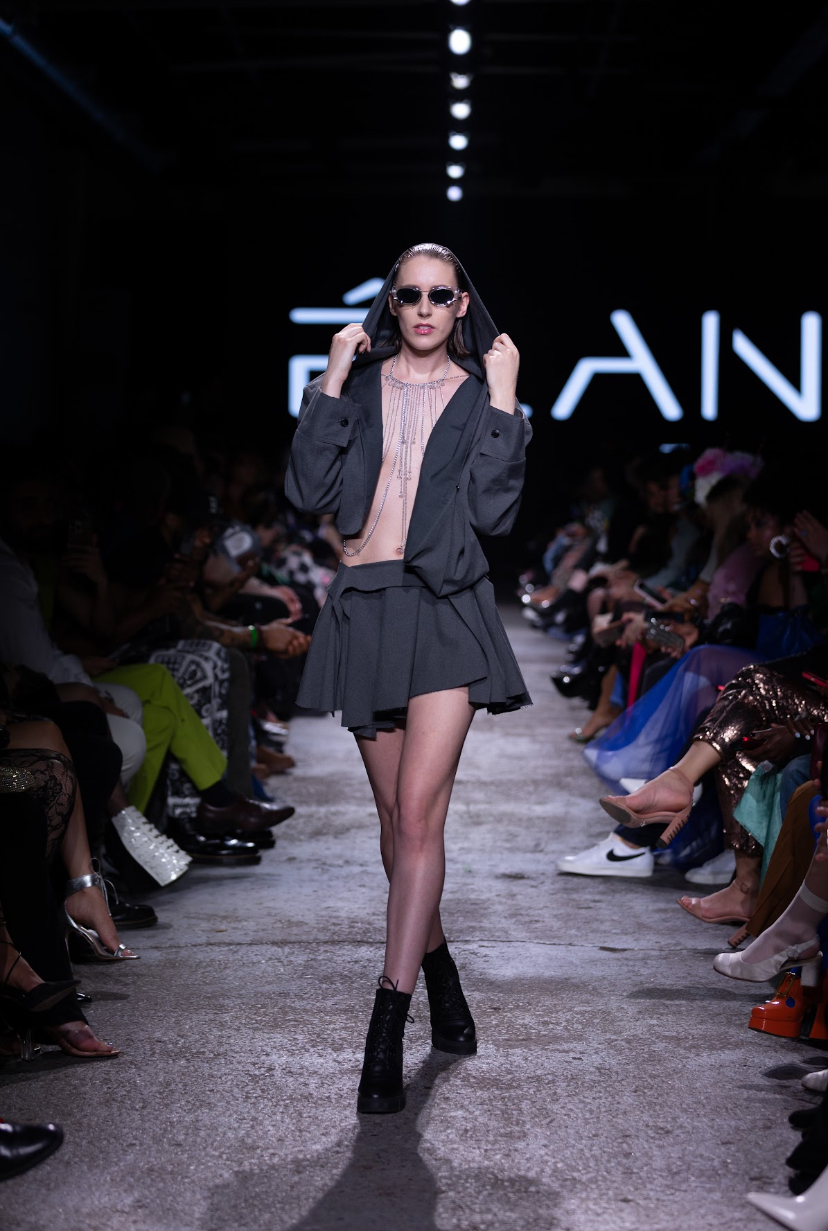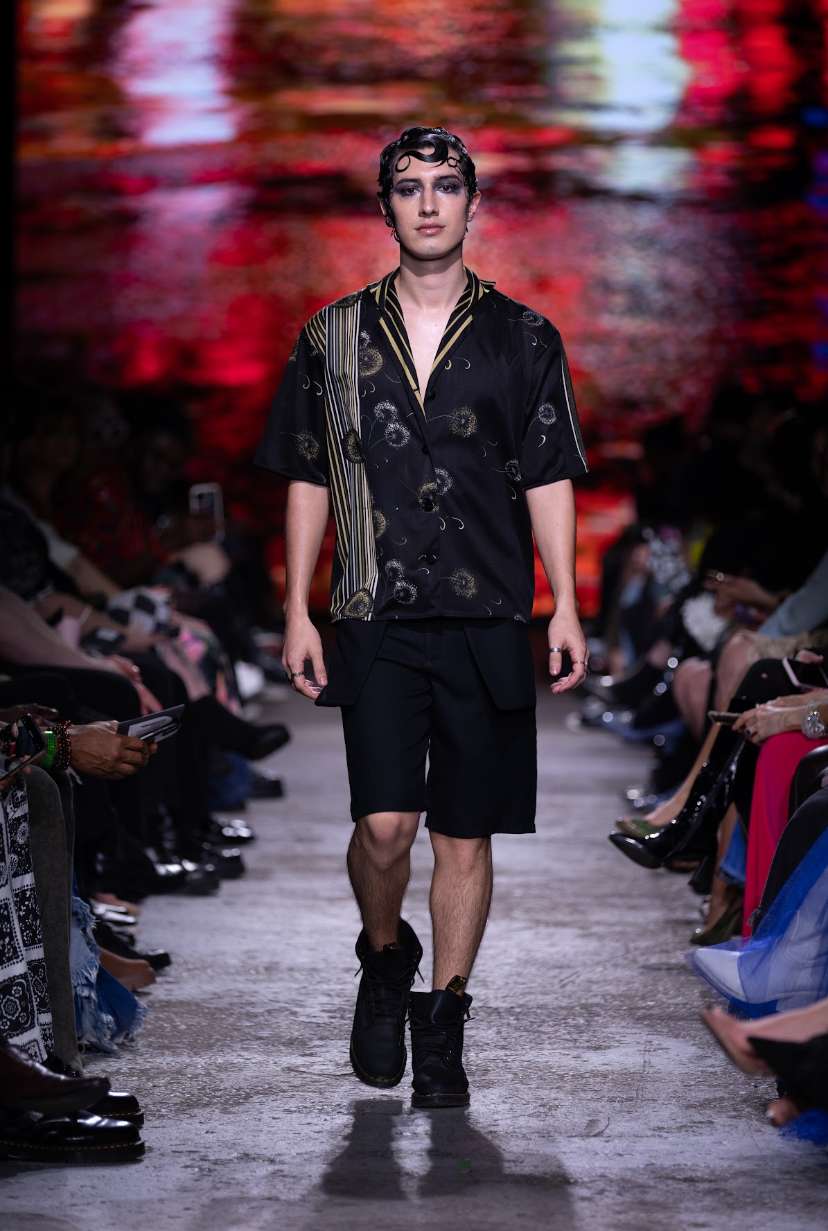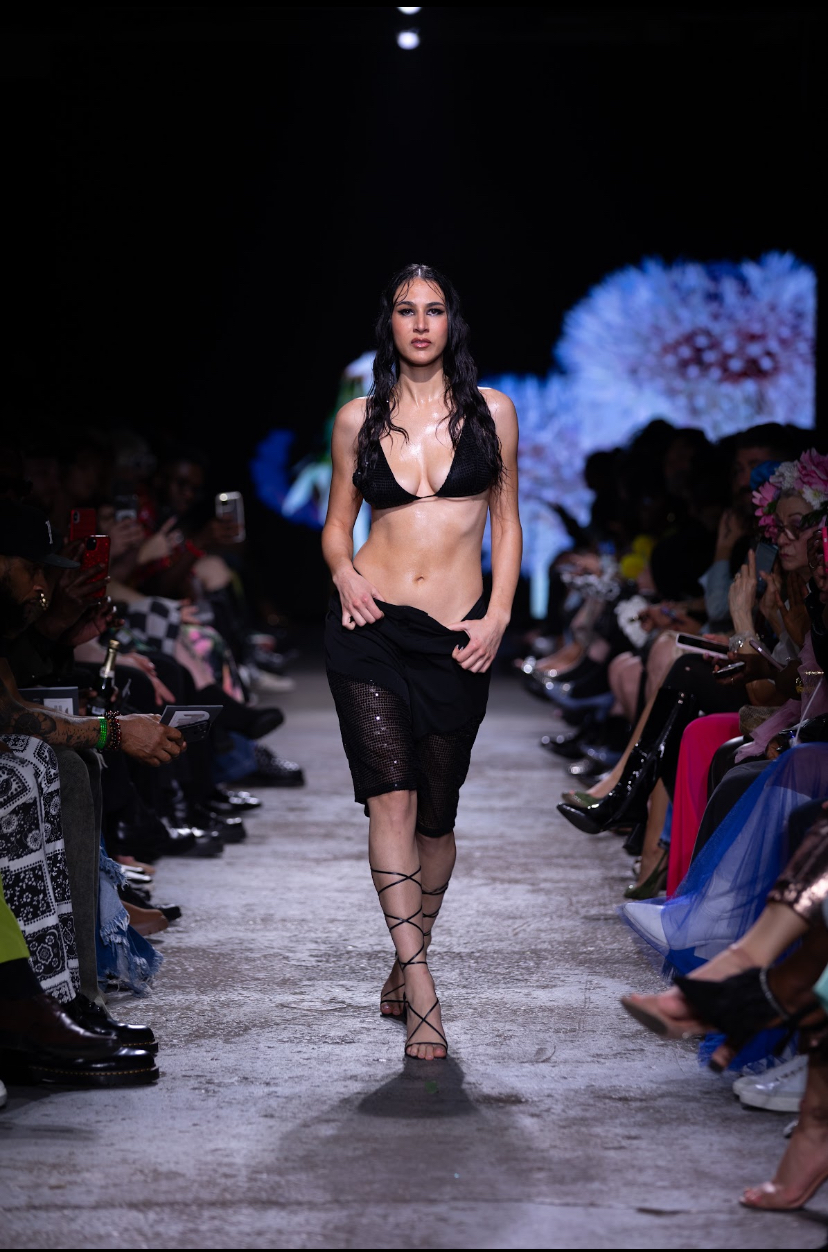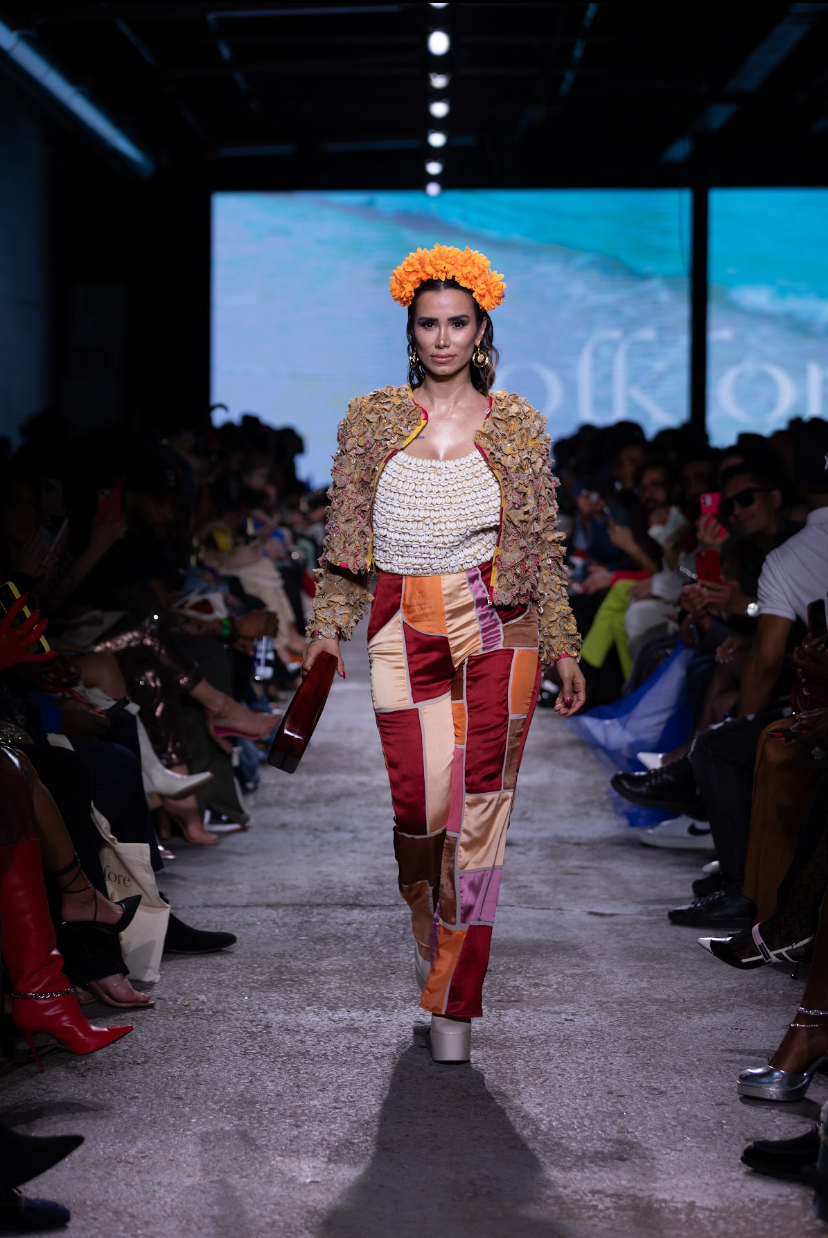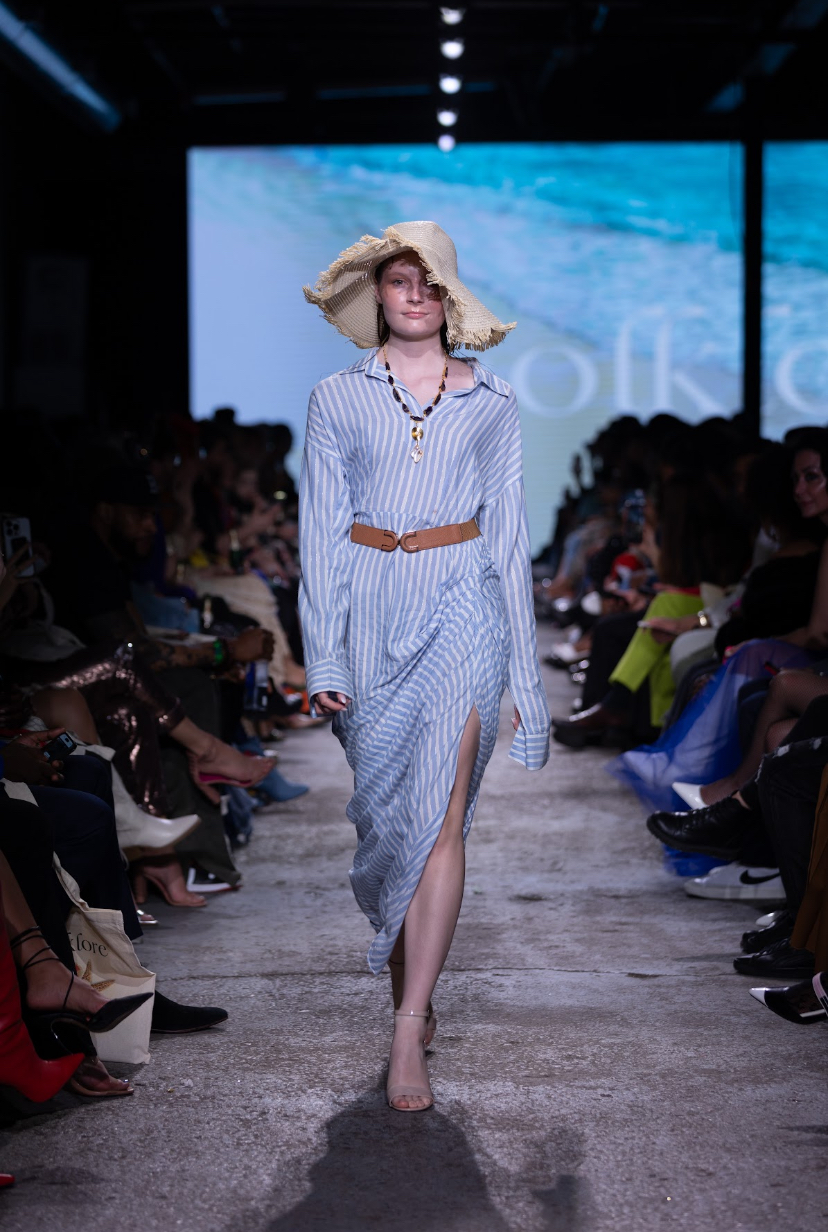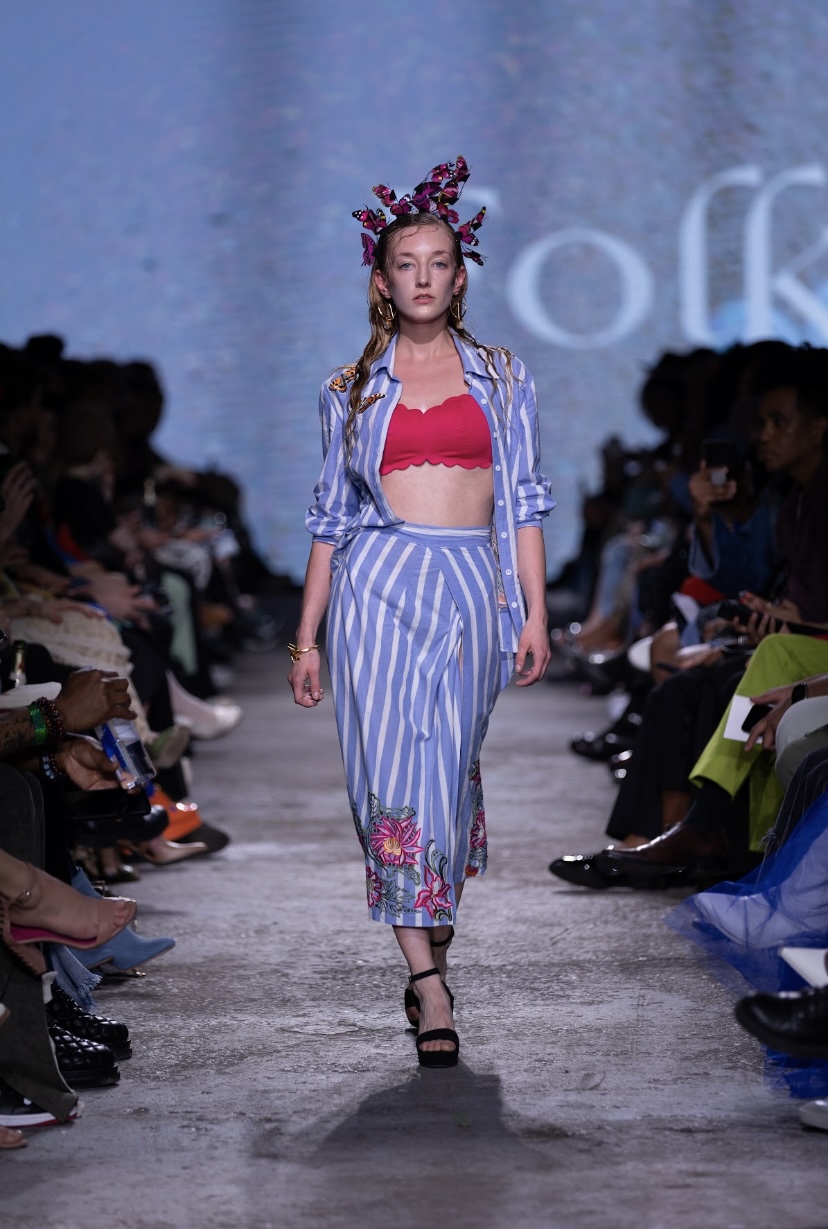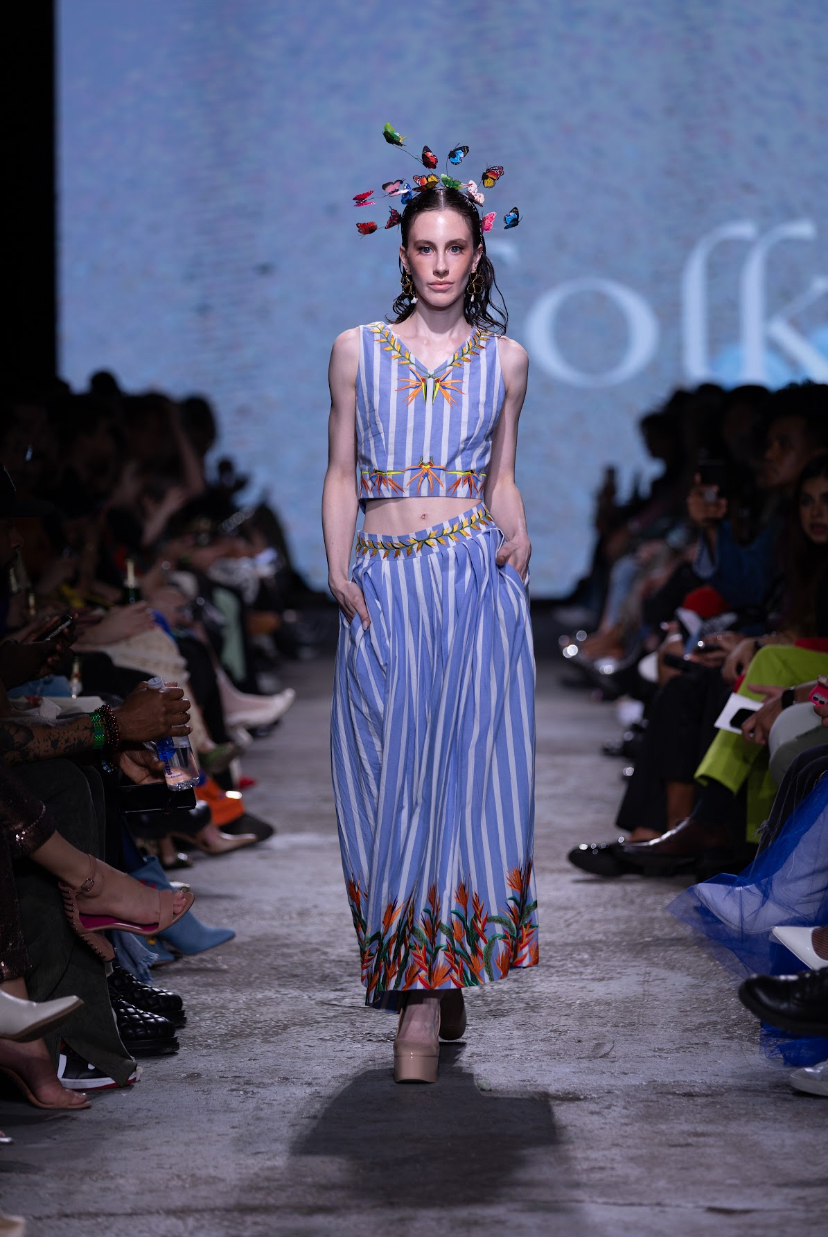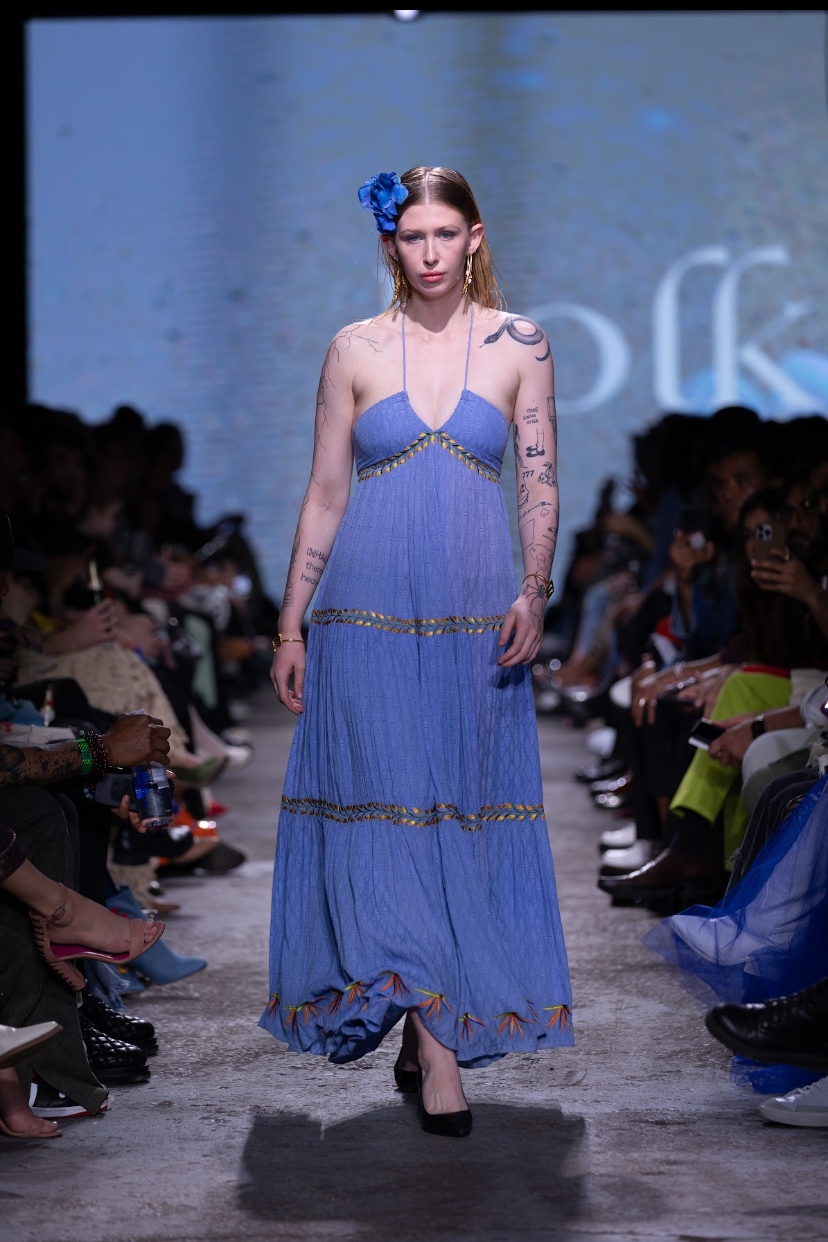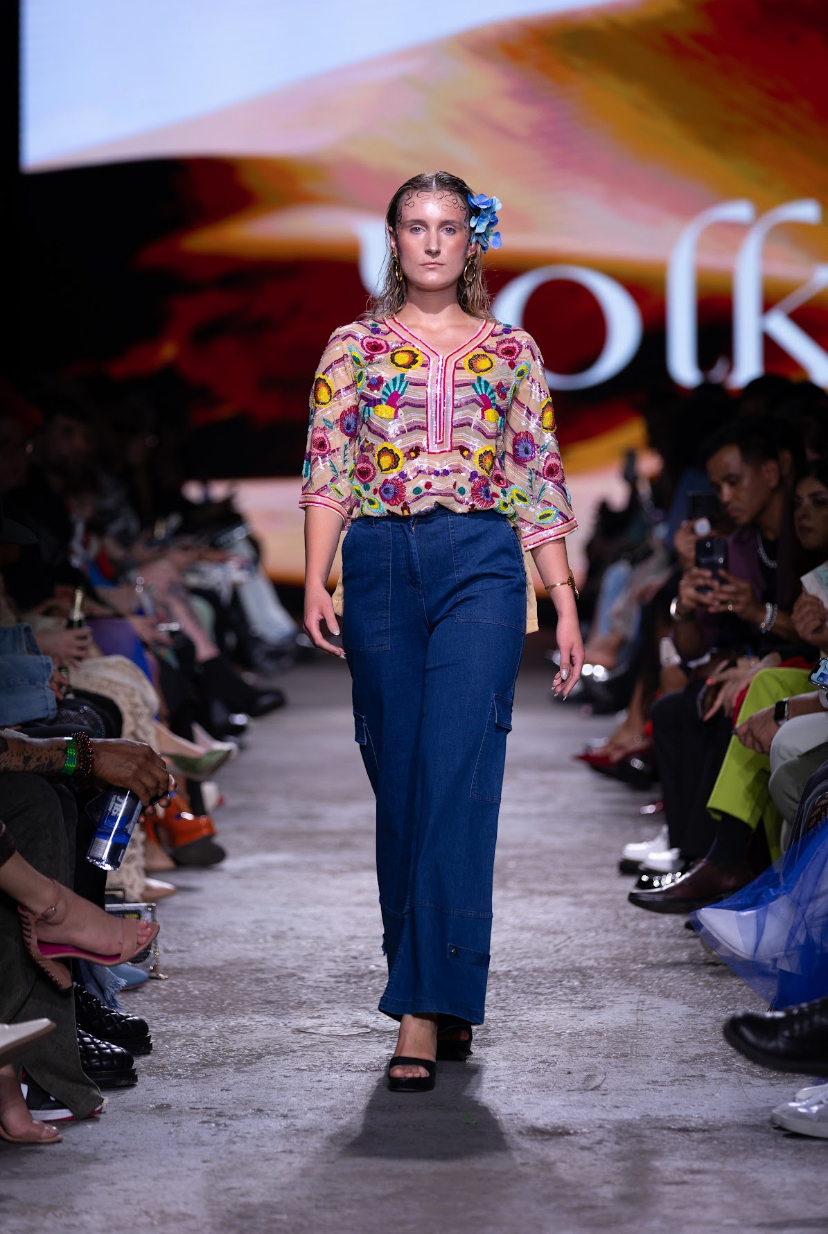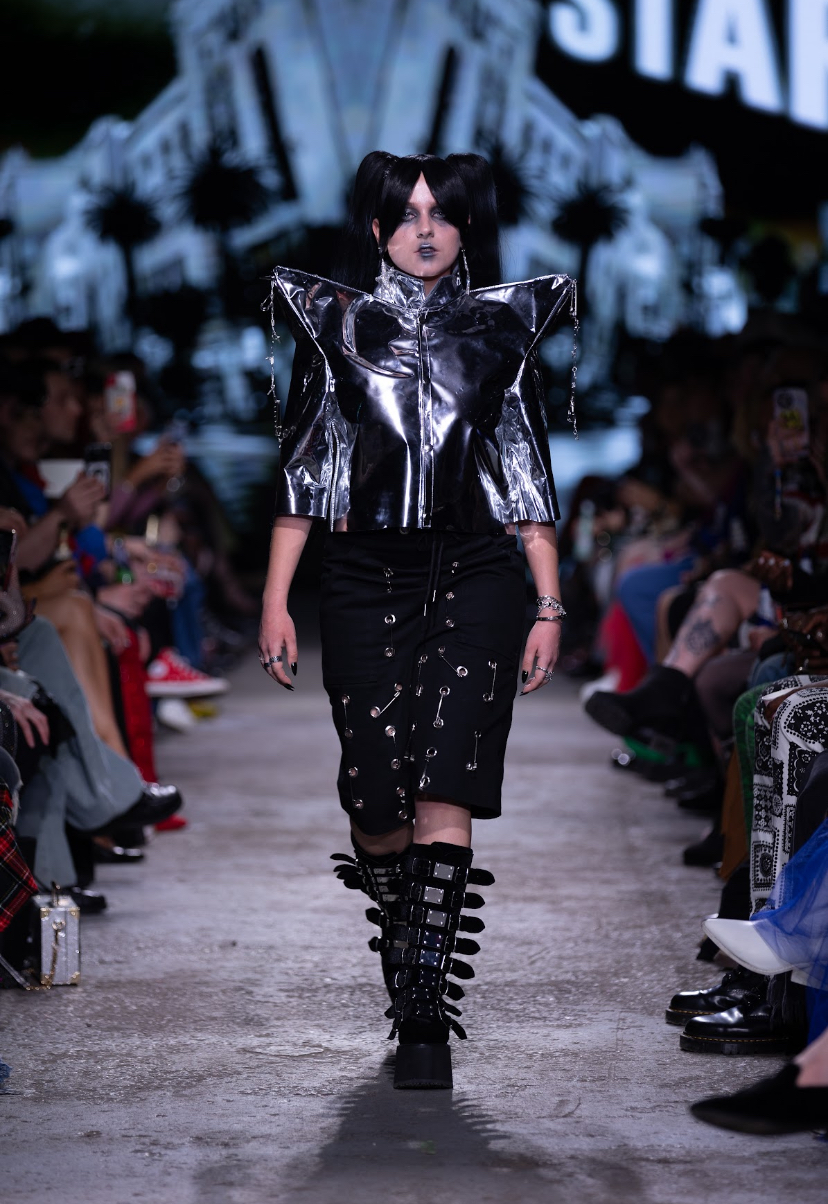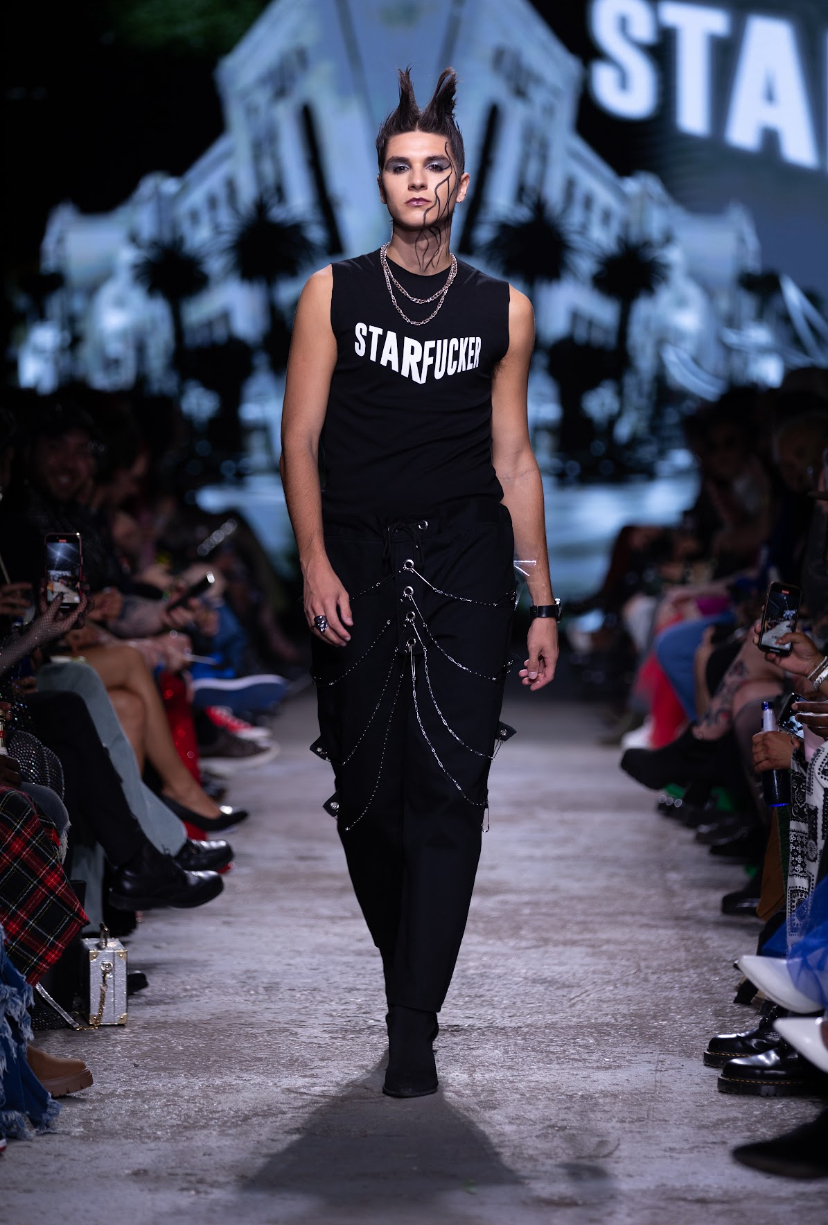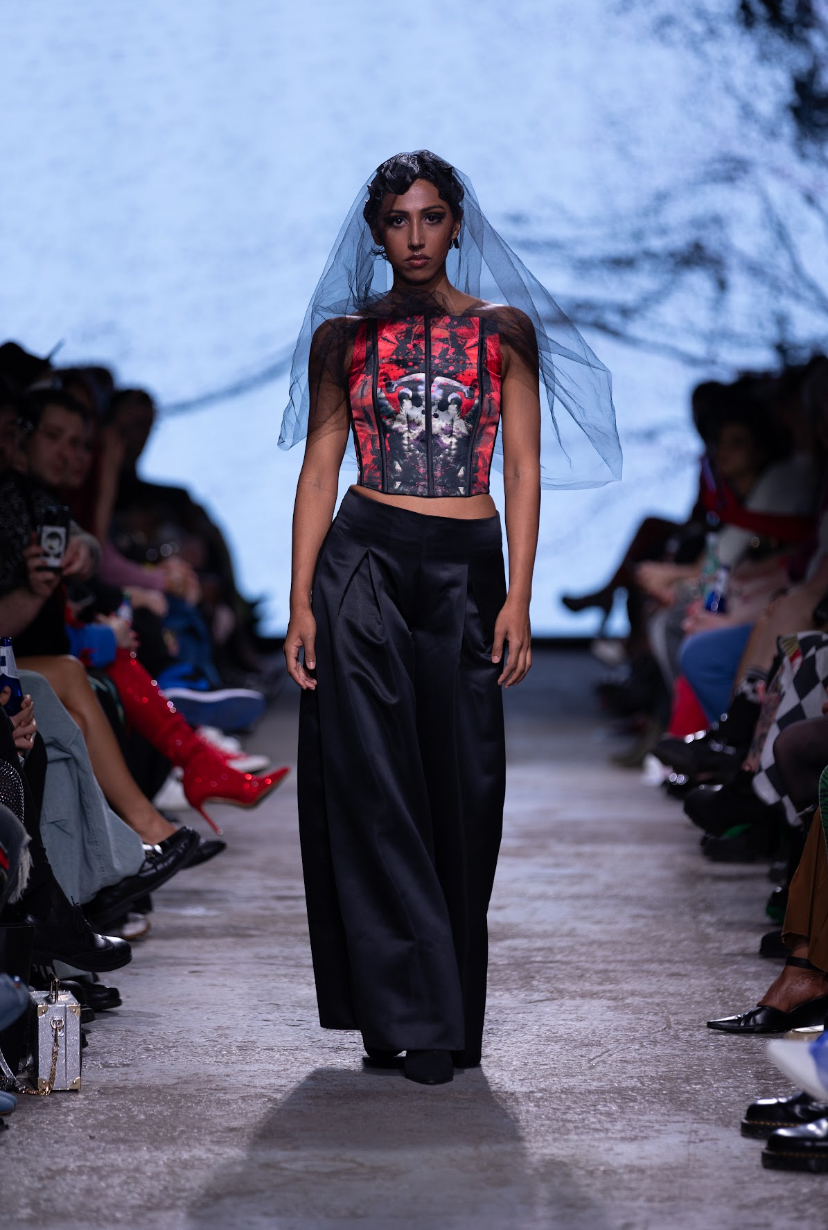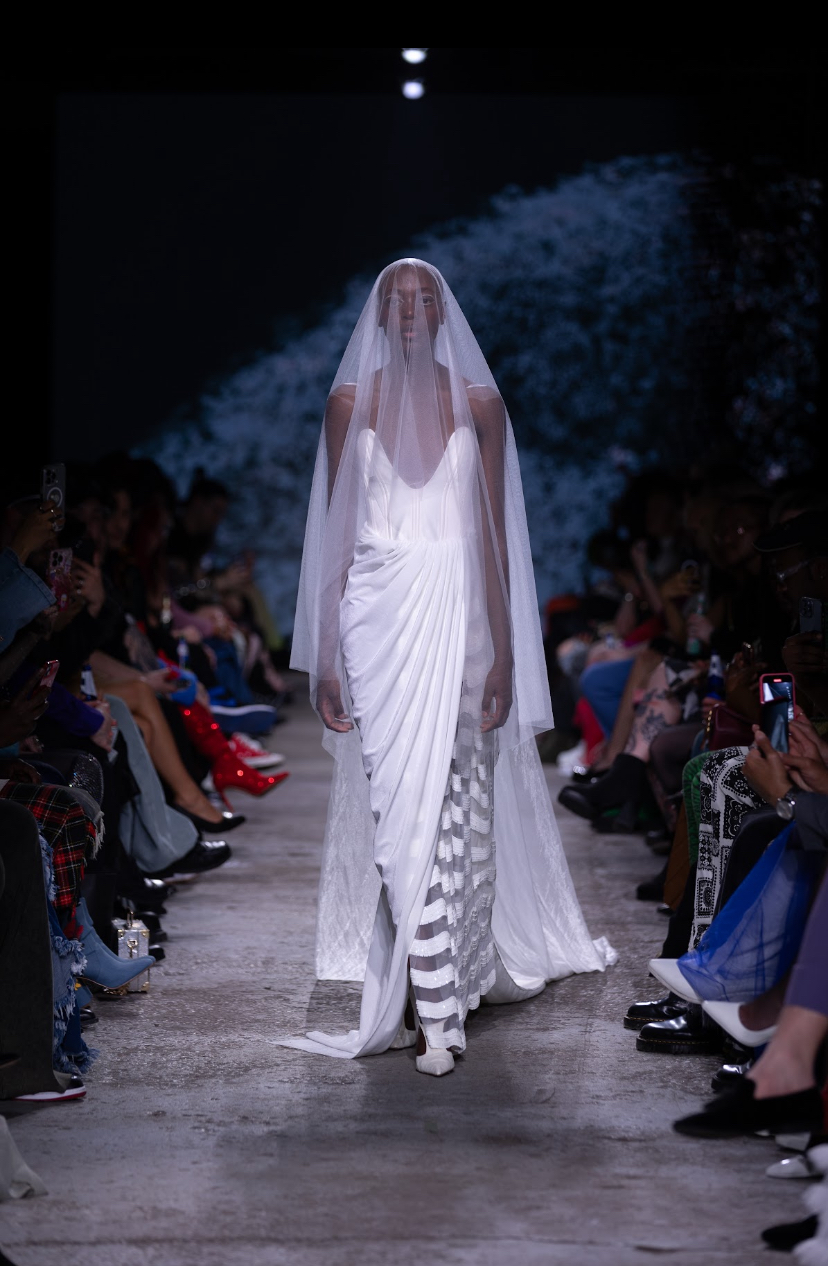Official FAT Recap - Day 4 SS24
- Astrid Superstar
- Sep 9, 2024
- 16 min read
For the final day of Fashion Art Toronto’s Spring/Summer 2024 season, the first iteration of their newly-dubbed 1664 Fashion Week, the energy that had been steadily coursing through the venue for the duration of the weekend maintained its vigor and ended with a bang. Attendees knew that this was their last chance - for the season, at least - to dress to the nines and indulge in the welcoming warmth of the local fashion community.

The audience in the runway room of Fashion Art Toronto's 1664 Fashion Week, SS24.
Photo by Chris Cheung.
MEGLIO & MEGLIO
Meglio & Meglio kicked off Day 4 by demonstrating to the world that confidence can be comfortable. Their opening video began in a stark black and white, with featured vibrant prints slowly fading into colour. Models conquered the runway in a fast-paced tempo, wearing luxury loungewear made from high-quality Italian silks that were styled in a way to resemble power suits. Promising “an eclectic collection of luxury lounge and lifestyle pieces created to spark joy and confidence,” designer Shawn Timothy Hudson describes this collection as being created with “an eye for detail and bespoke construction.”
Hudson l utilized bold colours and eclectic motifs to complement and enuance the natural sheen of the fabric. We saw a recurring theme of florals combined with animal prints, such as cheetahs and tigers, both being common symbols of strength. The use of alternating patterns were done so skillfully that instead of ‘clashing’, they created their own kind of serendipitous harmony.
Garments were often tied at the waist, with bandeau tops, bras and tanks exposed. Jewelry, provided by Famluxy, was expertly tailored to each look. Bracelets, earrings and necklaces were often colour-matched to the outfits. The pieces were not overpowering, but provided a touch of refined class that amplified the beauty of the garments and the models themselves. Heels and go-go boots added a sense of intensity and punch to the presentation.
Meglio & Meglio's featured collection. Fashion Art Toronto's 1664 Fashion Week SS24.
Photography by Jack Hathaway.
Makeup was glamorous, emphasising the models’ unapologetic gaze as they showed off their sexy ensembles. Hair was frequently tied into low ponytails, elegant buns or twists, adorned with ribbons that fluttered behind the models as they walked. The empowering display, which screamed ‘loud luxury’, was a testament to the resilience and prowess of women in any context.
DESIGNERZ DEN BY ESHA
Designerz Den by Esha’s collection, titled ‘Lamhein, the Moments’, was a nostalgic ode to summer fantasy. As an audience, we were transported to a fantasy realm where princesses wowed in their regal (yet understated) attire. More than one “wow” was heard amongst the crowd, as designer Esha Dhatt spared no detail in her creative process. “‘Lamhein, the Moments’ creates a sense of nostalgia, romance, and the lasting essence of time,” Dhatt explains. “Draped in dreamy pastel hues and timeless elegance, each piece tells a story of cherished memories and moments, capturing the essence of romance in every stitch.”
Featured dresses and sets (think Jasmine in Aladdin) were light and flowy, beautifully complementing the models’ bodies. Pastel palettes, crystal tassels, and intricate corsetry are sure to make any anyone who tries them on feel like royalty, with this collection being no exception. Incredible beadwork, feathered sleeves, and smatterings of rhinestones and pearls enhanced the opulence and sumptuous luxury of the pieces. Some looks were paired with graceful gloves or light shawls, with the finale look featuring a cape with a soft mohair trim.
"Lamhein, The Moments", Designerz Den by Esha. Fashion Art Toronto's 1664 Fashion Week SS24.
Photography by Jack Hathaway.
Hair was often delicately slicked back or put into regal up-dos with dainty tiaras and one look featuring a padded satin headband. The jewelry they wore was similarly delicate, yet classic, and their makeup was bold in the most elegant way. These gowns and sets would be the perfect choice for an evening ball or even a hazy afternoon spent frolicking in fields.
TRAN THEIN KHAN DESIGN
Trần Thiện Khánh’s ‘The HUE of HUE (Royal Heritage Fusion: A Contemporary Rendition)’ was nothing short of majestic and breathtaking. For many seasons now, Khánh has dazzled audiences with their imaginative interpretations of the traditional ‘Ao Dai’ garment - translating from Vietnamese to “long dress”, characterized by a slim floor-length silhouette. The show was opened by a live musical performance, and followed by perhaps one of the most stunning displays of craftsmanship to be seen at Fashion Art Toronto.
A bell began to somberly toll and the screen was filled with an image of a Vietnamese landscape, with a wispy fog beginning to roll in over the rolling hills. A man in a black ao dai emerged with a microphone, opening the show by singing in Vietnamese. And then, the models - one by one, as graceful as swans.
For this collection, Khánh took inspiration from patterns found within the ancient court of Vietnam and re-imagined them in a modern context. Garments featured “marries the opulence of traditional court designs with the versatility of modern materials,” Khan explains. “Drawing from the rich cultural tapestry of my country, each piece is a testament to the enduring legacy of our indigenous heritage.”
"The Hue of Hue", Trần Thiện Khánh. Fashion Art Toronto's 1664 Fashion Week SS24.
Photography by Jack Hathaway.
The silhouettes and patterns of the garments were certainly traditional yet contemporary, but most impressive were the prints and embroidery that depicted Vietnamese landscapes in abstract ways. Rich blues invoked deep water, while vivid greens conjured images of lush flora. However, it is in the details where Khánh truly shines. The stoning on the garments was nothing short of incredible, and one cannot help but marvel at the dedication required to create such a thorough addition to the designs. Accessories, such as hats and parasols, were similarly adorned with tassels and complex beadwork. Through the movement of the fabrics, the viewer could almost feel the soft breeze as if they had been transported to another world.
ZEDES
Zedes’ collection, inspired by the beauty and splendor of nature, embodied spring themes by directly taking inspiration from a myriad of different flowers. Made to mimic orchids and peonies, the garments utilised traditionally feminine silhouettes and gave them a floral twist. The dresses were bouncy and matched the upbeat music accompanying them.
Designer Zarah Sadeghi didn’t shy away from using as much tulle and frills as necessary. One look in particular was created so that the model herself became a flower, with a tight-fitting and delicately stoned pink bodysuit extending over her stiletto heels, long strips of fabric blossoming from her chest like the filaments of a flower. As this look was quite early in the show, it set a tone of fantasy that colored the rest of the presentation - flowers had come to life, à la Alice in Wonderland! Another comparison we could not help but make was to Disney princesses - we have a Belle in a simply stunning gold gown, and Lise made a tattoo’d sleeping beauty in a baby pink creation. Another standout look featured a model in a nude bodysuit with vines of ivy crawling up the side of her face and into her hair. The palette was a blend of soft creamy tones and the intense hues that only nature can provide.
Zedes' featured collection. Fashion Art Toronto's 1664 Fashion Week SS24.
Photography by Jack Hathaway.
It was clear that Sadeghi had done her homework in regard to floral anatomy, utilizing unique elements such as frills, rolled curlicues and oversized appliqués to further personify all different types of florets. For a brief moment, the runway had completely transformed into a thriving meadow.
WAVE FIBRE MILL + MILO & DEXTER
“First you raise a sheep!”
This statement, along with an absolutely adorable photograph of a sheep in its pen, remained onscreen through the duration of the collaborative show between Wave Fibre Mill and Milo & Dexter. As an audience, we were asked by the omniscient voice on the screen, “what if we could create a garment that does not harm?” A wonderful idea, especially in our current fast-fashion obsessed culture. The thing that makes Wave Fibre Mill so intriguing is their simple - yet genius - approach. The show hadn’t even begun and we were already hooked.
Wave Fiber Mill and Milo & Dexter came together for their Spring ‘24 showcase to create a collection that demonstrates the magnificence of eco-conscious fashion. The wool utilised for the creation of the textiles was locally processed in Ontario. In the words of designer Wave Weir, the collaboration with Montreal-based garment manufacturer Milo & Dexter “allows for a volume of environmentally responsible clothing to be available allows for a volume of environmentally responsible clothing to be available, totally "Made In Canada".” Their pieces are “meant to last a lifetime and return to the earth as nourishment, not toxins”.
The first model stretches as if waking from a peaceful slumber, embodying comfort. In a similar fashion, models continued to beam down the runway - smiling, twirling, and playing with their hair. The natural dyes created gorgeous, earthy tones that exuded luxurious comfort. Despite this sort of clothing usually being found in more rustic contexts, Weir was able to give them a high-fashion edge. We saw cardigans, capes and loose-fit pants, but expertly tailored to fit the body perfectly. Styling and makeup were quite classic; jewellery was limited to wooden beaded necklaces and earrings.
Wave Fibre Mill's collection, in collaboration with Milo & Dexter.
Fashion Art Toronto's 1664 Fashion Week SS24.
Photography by Jack Hathaway.
Wave Fibre Mill is here to make it clear: it is possible to create fashion that honours both the wearer and the resources used to sustain ourselves.
DONTALATO
Dontalato’s runway debut “The Hues Collection”, lovingly curated by designer Cherina Sima Marie Zerbo, was a love letter to the natural opulence of their African heritage. Onscreen was a video documenting the process of creating cotton textiles - from harvesting to plant, to a woman using a loom while sitting outside. It was grounding, in a way - audiences and consumers tend to focus on the clothing itself and forget about how much work happens before the assembly process.
The dresses and pajama-like sets complemented the models’ body beautifully and were quite breathable, perfect for hot summer days. We saw many garments that were clearly woven from a loom, with interesting use of beads incorporated throughout. The tops might have straps made of them, or might have beaded strings hanging from the back. We saw billowy long sleeves matched with miniskirts - the looks were sexy, but comfortable.
"The Hues Collection", Dontalato. Fashion Art Toronto's 1664 Fashion Week SS24.
Photography by Jack Hathaway.
It was clear to see that the makeup and hair teams - overseen by Creative Hair Director Dylan Cruikshank and Creative Makeup Director Jez Taylor - had fun with this one. In contrast to the simple palettes of the clothes, striking tones took the form of graphic liner (on eyes, of course, but even lips!) or bright blush. Large white or red beads were woven into traditional braided or waved hairstyles. It was a perfect match for the simplicity of the clothes and their colour palette, allowing viewers to better focus on and honour the materials themselves.
ELANTUR
Elantur’s collection ‘Elegance Essence’ combined the contemporary mystique of the Little Black Dress with the drama of Darren Aronofsky’s 2010 film Black Swan. Designer Gazal Shalchi describes the collection as an “intersection of modern elegance and comfort”, with a goal to “redefine contemporary chic.” She continues, “each piece narrates a story of timeless grace and versatility.”
The models were black-clad, save for one shimmery, gold hooded top (which, for us, was a throwback to Lady Gaga’s iconic wardrobe in her early days). We open with a large black gown, cut away at the front to reveal the models’ legs. For the last time that weekend, we relished in the invigorating feeling of having the fabric brush past your ankles as the model walks past. A fully immersive moment like that is, in our opinion, the best way to open a show: it grounds the audience, adding another of the senses to the experience, and reminds us that we are truly here, witnessing the action up close. What a thrill!
Makeup was clearly heavily inspired by Natalie Portman’s performance in the film’s penultimate dance sequence - even going so far as to include small feathered details and glimmering rhinestones around the eyes. Dresses were sexy and sleek, but the ruffled detailing gave them a noticeably girlish touch. Perhaps, this is a depiction of the transition from the cruelties of girlhood to the trials of womanhood. Still, the models were depicted as confident and poised, adorned in accessories that made them seem almost unreachable - chunky gold jewelry, a necklace that wouldn’t be out of place in Cleopatra’s wardrobe, sunglasses ending in sharp points - cultivating an essence that is truly larger than life.
"Elegance Essence", Elantur. Fashion Art Toronto's 1664 Fashion Week SS24.
Photography by Jack Hathaway.
The star of the collection was without a doubt the finale look - Shalchi’s Edwardian rendition of the Odile (the Black Swan maiden) costume. While significantly more modest than the other garments shown, the intricately jeweled tiara emboldened the model with a grandeur that stood out from the rest. The eye makeup was right from Swan Lake, with a classic red lip cementing the glamour. There was something unsettling about her stoic demeanor - as of it was the Black Swan of lore, come to life!
FDS
FDS’ ‘POLLEN RAIN’ was a conceptual exploration of rainy spring days through a twisted lens. “I am going for a darker approach this season,” says designer Filomena Dos Santos, “giving villainous street vibes mixed with couture.”
The sound of smattering rain, punctuated by heavy bass, filled the room. The screen lit up with a moody looping video of raindrops falling into a puddle, emphasizing the reverberations in the still water. The first model emerged with an umbrella, while many of them seem to have been misted right before they came on, a dewy sheen emanating from their bare skin.
Models confidently strolled down the runway in see-through tops of translucent mesh and sheer raincoats, as the collection offered a sleek sexiness to rainy-day wear. Another model carried a bouquet of dandelions, the standout print and cementing the “pollen” element of the collection. We see inspiration from this as well in the incorporation of pompom trim and frayed edges.
"Pollen Rain", FDS. Fashion Art Toronto's 1664 Fashion Week SS24.
Photography by Jack Hathaway.
For hair, inspiration from the infamous ‘wet look’ was on full display, and makeup was fairly light. Hair was fixed to the scalp in glistening curlicues, as if they were just caught in a storm. The intensity with which the models entered the scene certainly made them look intimidating, as if they were a personification of the storm itself.
WORLD OF FOLKLORE
‘Under the Sun’ by World of Folklore transported audiences to dreamy beach landscapes and carefree summer days. Designer Sana Sampra noted that ‘Under the Sun’ “embodies beachy vibes and sun-kissed adventures”. She achieves this by “seamlessly blending relaxed sensibilities into resort wear,” while “each dress holds familiarity yet surprises with unexpected detailing.”
On top of this, Sampra was sure to mention her dedication to eco-conscience in her work. To her, the collection is also a “celebration of sustainability, a commitment to ethical fashion harmonizing with the environment.”
We open with a flood of blue light and the peaceful sound of waves crashing on the shore. A beautiful ocean sunset fills the screen, fully immersing us in a world of Sampra’s creation. The clothing was textured and frilly, with a substantial variety in cut and silhouette. Garments were a full array of the palette you might find in a coral reef - softer coral tones, vivid yellows and reds, creamier blues and purples. Two dresses were an ombre of blues and a section of a light beige, perfectly representing sand. One garment even resembled seaweed, while others had a clear inspiration from mermaids (we see you, cowry-shell bra).
Butterflies and flowers were represented heavily in the detailing, but also in the accessories, as almost every model had a crown of either. Some models seemed as though they had butterflies, fixed with wire, dancing around their heads. Other accessories were more of a representation of beachwear, such as large floppy straw hats or a flower tucked delicately behind one ear. Makeup was a natural soft- for styling, most of the jewellery was gold and simple.
"Under the Sun", World of Folklore. Fashion Art Toronto's 1664 Fashion Week SS24.
Photography by Jack Hathaway.
Models seemed relaxed and content, as though they were truly on the seaside sipping on Piña coladas. Perhaps Sampra said it best - noting that the collection represents “ a lifestyle, an experience, and a celebration of the beautiful harmony between tradition and modernity, all under the sun.”
BRANDON KEIR
Brandon Keir's 'STARFUCKER' was a grunge-infused take on Hollywood glamour, the hunt for fame, and the “unapologetic pursuit of celebrity status”. Most chase and chase and chase, only to find that external validation means nothing if people are only admiring the mask and not the person behind it.
In a stark contrast of black, white and silver, ‘STARFUCKER’ is a perfect example of the type of show Fashion Art Toronto denizens have come to expect from Keir - mixing grit in glamour in a way that is poignant and fun but appropriately self-effacing… it doesn’t seem to take itself too seriously. These attitudes make Keir’s punk-rock displays a highlight of any fashion season. An addition of headpieces provided by IMAGO Millinery (who just displayed a collection at the ROM’s collab with us earlier this year) could not have been better matched, as the creations enhanced and elevated the collection in a truly harmonious fashion.
Fittingly, “Fucked My Way to the Top” by Lana Del Rey opened up the show with a smattering of strobe lights. With pentagrams, safety pins, pasties, and chains, the collection felt reminiscent of stars such as Lady Gaga (who, notably, had to fight for her spot at the top.) Gaga in particular was known for using religious imagery to portray the kind of dissonance one feels trying to be accepted by the mainstream whilst fighting against everything it stands for. This stands to be no surprise for those familiar with Keir’s work, as Gaga has always been, and certainly remains, a primary influence in his style and work.
Makeup was clearly inspired by drag, another form of performance that is known to denounce societal injustices. Many of the models were themselves notable local queens (Luna DuBois, Sweaty Clown and Helena Poison to name a few, with their iconic mugs done up in corresponding colors to the collection). Hair, when not (at least partially) obscured by an IMAGO hat, was similarly whimsical - model Vini’s short hair was done up in two points à la horns, and Helena Poison wore a rhinestone-studded wig.
Clothing was larger-than-life, constructed mostly in black or white but with a metallic silver material adding an integral piece to the look - a giant cross tied around a chest, serving as the boning in a clear vinyl corset. Silver stars dotted a fabric used in multiple looks, but our favorite use of the symbol came in the form of a silver jacket, with huge spikes protruding from the shoulders to create a silhouette of the shape itself.
"STARFUCKER", Brandon Keir. Fashion Art Toronto's 1664 Fashion Week SS24.
Photography by Jack Hathaway.
The finale look, however, was the biggest talking point - a straitjacket-sort of dress with the words ‘IMMA BE A SUPERSTAR” airbrushed onto it. Worn by Sebastian, none other than the designer behind IMAGO Millinery, they navigated the runway with bound hands and pleaser heels with more grace than the average person could pull off. An oversized leather shape, made up of sharp angles, sat atop their head, secured tight with a dangling strap under their chin. You could hear audible gasps when Sebastian turned onto the runway - we were absolutely rapt. And we can’t wait to see what Keir has in store for us in the future!
DESATITA BY MOHIT
Desatita by Mohit’s debut runway show, ‘Still Somewhere Inside Me’, is a story told through clothing. Even with no words spoken, the choreography was masterful as sound and sight collide to form a captivating narrative.
“In the course of a life, human beings take their physical body with no past conditioning,” designer Mohit Maina says of the concept. “Along the way of life, [they] encounter all sorts of emotions like pain, hurt, fear & suffer numerous traumas. [They] reach a point where that person enters such a dark space, they stop recognizing themselves and it seems impossible to get out of that darkness. However, that child is still living inside that person and [is] calling for help.”
It begins with a blank slate; a white dress and an abnormally long veil that covers the models entire face. In the background, a video showcasing the formation of a foetus plays, focusing on each cell that makes up an organism. As the show goes on, the models begin exposing their organs and, slowly, the pure canvas is tainted by red. Their heart is exposed, raw and vulnerable, until crimson takes over and innocence is long forgotten. Everything turns red, including the lighting and the audience, and eventually the same gown seen in the beginning is simply black. Two models, in gowns white and black, take to each side of the runway, intersecting at the pit as their long trains brush past one another. There is no sign of pain nor happiness, just a hardened shell.
"Still Somewhere Inside Me", Desatita by Mohit. Fashion Art Toronto's 1664 Fashion Week SS24.
Photography by Jack Hathaway.
Backed with harsh, oft-jarring strings, the room was otherwise completely silent as the show progressed. The audience seemed to be entranced, until designer Mohit Maini took the stage to a standing ovation and raucous applause.
STORRVELDI
To close the week, we had Storrveldi’s ‘Shadows of Forgotten Ancestors’, a tribute to those who fought to create the world we live in today. To designer Stjorn Revaldi, the collection comprises “otherworldly, avant-garde garments which are inspired by the ghost of my ancestors.” Revaldi continues, “each garment hosts an element of horror, as to represent the hardships the ancestors went through. The collection is meant to intrigue you, bewitch you with its beautiful colours and then haunt you with its human aspect.”
And intrigue it did. Snippets from The Color of Pomegranates (1969), directed by Sergei Parajanov, played in the background as models not only walked, but performed on the runway - each with a signature gait that brought the outfits to life (a Joan of Arc figure extending her rapier en garde, for example, posing at the pit with in raised above her head in a show of triumph). Model Amelia, in sort-of Mother Mary themed regalia, fully embodies the character, looking haunted and lost. Model Luz does a bit of an interpretive dance down the runway, gracefully leaping and reaching towards the camera with extended arms.
The gowns were medievally eclectic and heavily featured chainmail, a staple in fashion at the time, as well as intricate bead embroidery and patchwork. Garments took up space due to their large puff sleeves, also a common trend of the era. Makeup was eclectic and served to accentuate the looks - pure white eyelashes set against smoky, kohl-rimmed eyes, faces were flushed and lips left pale. Every outfit had a headpiece, whether it be a fluffy fur hat, an oversized bonnet or a long, lace veil.
"Shadows of Forgotten Ancestors", Storrveldi. Fashion Art Toronto's 1664 Fashion Week SS24.
Photography by Jack Hathaway.
Symbolism within the collection was strong - hearts affixed to chests, pomegranates and crosses attached to torsos. Velvets in tulles in rich colours brilliantly emphasized the ‘fresco’ painting technique influence. Cutouts of bones and muscles gave the impression that the models were wearing their skin inside out. The final look, brought to life by model Hyla, was a depiction of the story of Adam and Eve - a tale of the first human beings and the roots of their self-serving nature.
Storrveldi’s ‘Shadows of Forgotten Ancestors’ was the perfect ending to the season and truly embodied Fashion Art Toronto’s core values: artistry, boldness, and self-expression.
As Fashion Art Toronto continues to grow with each passing season, more and more Canadian designers are able to participate in the city's longest running and largest Fashion Week. Toronto's fashion portfolio is as diverse as its culture and its people. We are privileged to be able to bare witness, with every show, to just how much talent and passion exists in our scene. We were blown away by the roster of this season, and anxiously await the next!















































































